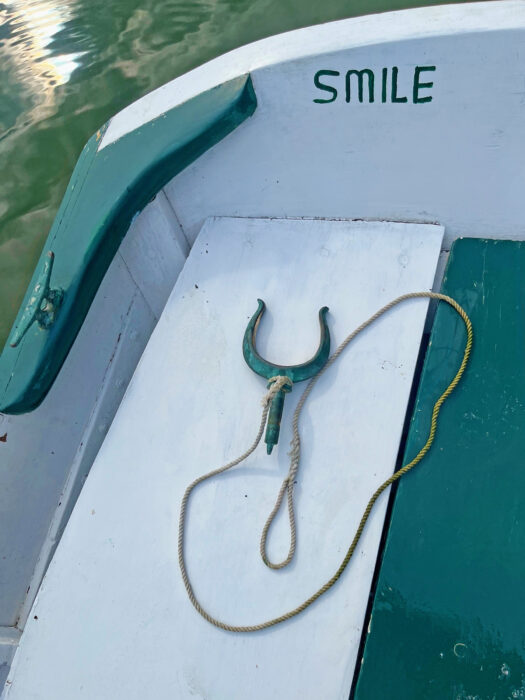I’ve always set up my boats so that I can insert oarlocks and place oars with one hand. It’s a useful technique that comes in handy on multiple occasions: beach launching, when I can’t preset oars and locks but need to push off hard and get going; changing rowing positions while underway in order to trim the boat for shifts in wind and waves; switching between sailing and rowing, when I need to ship or remove oars and locks while handling other gear; and, when coming alongside another boat or dock, it helps to be able to quickly ship one oar and its lock while using the other oar to scull the boat in sideways.Many conventional horn oarlocks have a lanyard or little chain with a toggle leading from an eye on the bottom of the lock through the socket. Such connections are useful for tying the oarlock to the boat, but for me they render one-handed operation impossible—I need one hand to insert the oarlock and another to pull-through the lanyard or chain, either of which can get bunched up inside the socket. However, tying your locks to the boat is undoubtedly a good thing, so a lanyard that doesn’t feed through the socket is called for. . Photographs by the author
Photographs by the author
Join The Conversation
We welcome your comments about this article. To include a photo with your remarks, click Choose File below the Comment box.









On our rowboats we tie a small weight on the end of a short lanyard coming off the usual hole at the bottom of the oarlock (eg a couple of large washers). This weight will pull the lanyard through the socket and allow one-handed placement of oarlock in socket. The weight is large enough to not pass through socket, thus also effectively tying the oarlock to the socket and the boat.
This is an interesting article, thank you for it Ben! I have also struggled with a chain and toggle on horned oarlocks and still didn’t have peace of mind because a link pulled apart at least once (could have been some unreasonable force on it; I don’t remember). I like your idea for modification of the round locks and might try it. But I don’t much mind damage to my oars (they are made from 2x lumber and 1/4″ plywood so far) and like keeping everything together. So I now use a system inspired by a suggestion in R.D Culler’s book “Boats, Oars, and Rowing”. I use round locks (not cut) with a leather but no button. Instead a narrow line runs from the inner edge of the leather to the top of the blade, secured with rolling hitches. That lets me pull the oars in but prevents them from ever sliding out too far. I’ll add some pictures. (You can see I am not a very serious amateur boatbuilder, with this eye-balled cheap oar design and the different colors from trying to use up old paint.)
Thanks Ben, interesting to see different priorities. My oars are in captive oval locks, which are themselves captive in the useable length of rope-wrap “leathers”. I do not have to worry about them becoming separated. After once losing an oar overboard at a critical time, due to snagging on weed, each oar has a lanyard with a snap. The snap clips onto lines run the length of the cockpit (for clipping things on). The boat has 3 sets of sockets plus extended standing sockets, and I can grab an oar loom with its lock one handed to move between them. When not in use and for transport, mounted big rubber pole clips hold the oars with the captive locks away from where they can do any damage.
I’ve seen the weight and lanyard system, and it works. I’ve never done it as I pull my oarlocks out of the boat when trailering to keep them from dinging up things as I haven’t made roadworthy carriers. And I generally just have one set of locks aboard rowing solo. But it does work well.
One thing a friend showed me is the use of locks in trailering. For many boats you will find that there will be a set of oarlock sockets just aft of your after tie down. If you insert oarlocks there and run the tie down through them it helps with fore and aft positioning and aids in dealing with chafe.
Variants on the lanyard and round lock system apparently were common in the livery era where the lanyards kept the oars on their leathers, kept the oars aboard, and kept the locks with the oars. Sometimes the lanyard was tied or spliced tightly around the loom down near the blade.